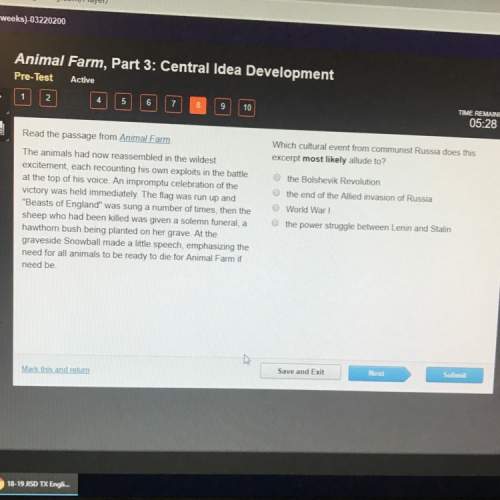I MET a traveller from an antique land
Who said: Two vast and trunkless legs of stone
Stand i...

English, 06.07.2021 02:10 carolinamleal04
I MET a traveller from an antique land
Who said: Two vast and trunkless legs of stone
Stand in the desert ... Near them, on the sand,
Half sunk, a shattered visage [face] lies, whose frown,
And wrinkled lip, and sneer of cold command,
Tell that its sculptor well those passions read
Which still survive, stamped on these lifeless things,
The hand that mocked them, and the heart that fed;
And on the pedestal these words appear:
"My name is Ozymandias, king of kings:
Look on my works, ye Mighty, and despair!"
Nothing beside remains. Round the decay
Of that colossal wreck, boundless and bare
The lone and level sands stretch far away.
Which of the following would be an additional example of situational irony?
Learning the traveler did not expect to see a broken statue in the desert
Learning the traveler found more ruins
Learning the king expected his statue to crumble
Learning the king knew he would be forgotten as time passed

Answers: 1


Another question on English

English, 21.06.2019 13:00
Ihave to write a narrative poem for an english assignment, but i cant come up with any topics/ideas for the poem. any topics?
Answers: 1

English, 21.06.2019 23:00
Select all that apply. because the length of his story is limited, short story writers typically:
Answers: 1


English, 22.06.2019 03:30
In just over one hundred years, between 1701 and 1810, 252,500 enslaved africans were brought to barbados—an island that occupies only 166 square miles (making it, today, one of the smallest countries in the world). the english then set out to conquer more sugar islands, starting with jamaica, which they took from spain in 1655. in the same period that the 252,500 africans were brought to barbados, 662,400 africans were taken to jamaica. thus, sugar drove more than 900,000 people into slavery, across the atlantic, to barbados and jamaica—and these were just two of the sugar islands. the english were eagerly filling antigua, nevis, saint kitts, and montserrat with slaves and sugar mills. they took over much of dutch guiana for the same reason. seeing the fortunes being made in sugar, the french started their own scramble to turn the half of the island of hispaniola that they controlled (which is now haiti), as well as martinique, guadeloupe, and french guiana (along the south american coast near dutch guiana), into their own sugar colonies, which were filled with hundreds of thousands more african slaves. by 1753, british ships were taking average of 34,250 slaves from africa every year, and by 1768, that number had reached 53,100. –sugar changed the world, marc aronson and marina budhos how do the authors use historical evidence to support their claim? x(a) they use secondary sources to show how french and english monarchs were indifferent to enslaved people. x(b)they use secondary sources to show that enslaved people often fought for their freedom after arriving in the caribbean. the answer is: (c)they use facts from primary sources to show how countries increased the number of enslaved people to produce more sugar. x(d)they use primary source interviews to show that countries could make more money in trading sugar without using enslaved people.
Answers: 1
You know the right answer?
Questions



French, 01.10.2019 15:30

Mathematics, 01.10.2019 15:30

Computers and Technology, 01.10.2019 15:30










Biology, 01.10.2019 15:30




English, 01.10.2019 15:30

Mathematics, 01.10.2019 15:30




